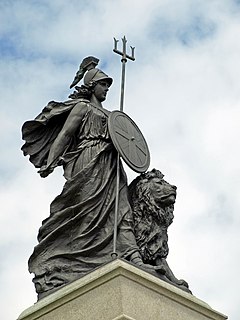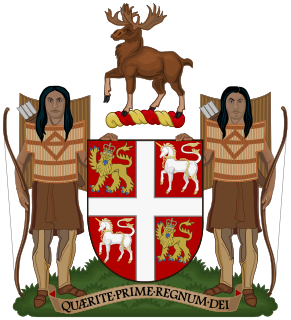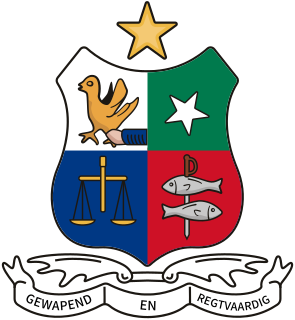
Zealandia is a national personification of New Zealand. In her stereotypical form, Zealandia appears as an evidently Western European woman who is similar in dress and appearance to Britannia. Britannia is said to be the mother of Zealandia. [2]

Zealandia is a national personification of New Zealand. In her stereotypical form, Zealandia appears as an evidently Western European woman who is similar in dress and appearance to Britannia. Britannia is said to be the mother of Zealandia. [2]
As a direct reference to the United Kingdom and the old world, she brought a sense of history and classical respectability to the colony during the formative years as a young nation. Zealandia appeared on postage stamps, posters, cartoons, war memorials, and New Zealand government publications most commonly during the first half of the 20th century. [3] Zealandia was a commonly used symbol of the New Zealand Centennial Exhibition, which was held in Wellington in 1939 and 1940. Four large Zealandia statues exist in New Zealand towns or cities; one is in Waimate, one is in Palmerston, and one in Symonds Street, Auckland, and one inside the Auckland War Museum. The first two (in stone) are Second Boer War memorials and the latter one (in bronze) is a New Zealand Wars memorial. Some smaller statues exist in other museums and in private hands.

Zealandia also featured on one penny definitive postage stamps issued in 1901 and 1909 during the reign of Queen Victoria and Edward VII when it went from being a Colony to a Dominion and was also depicted on a stamp featuring the coat of arms issued in 1929.
The woman who appears on the left side of the coat of arms of New Zealand is Zealandia. [2] [4] Apart from the coat of arms, Zealandia is seldom depicted in works today, or indeed referred to. [3]
Fasces is a bound bundle of wooden rods, sometimes including an axe with its blade emerging. The fasces is an Italian symbol that had its origin in the Etruscan civilization and was passed on to ancient Rome, where it symbolized a magistrate's power and jurisdiction. The axe originally associated with the symbol, the Labrys the double-bitted axe, originally from Crete, is one of the oldest symbols of Greek civilization. To the Romans, it was known as a bipennis.

Britannia is the national personification of Britain as a helmeted female warrior holding a trident and shield. An image first used in classical antiquity, the Latin Britannia was the name variously applied to the British Isles, Great Britain, and the Roman province of Britain during the Roman Empire. Typically depicted reclining or seated with spear and shield since appearing thus on Roman coins of the 2nd century AD, the classical national allegory was revived in the early modern period. On coins of the pound sterling issued by Charles II of England, Scotland, and Ireland, Britannia appears with her shield bearing the Union Flag. To symbolise the Royal Navy's victories, Britannia's spear became the characteristic trident in 1797, and a helmet was added to the coinage in 1825.

A commemorative stamp is a postage stamp, often issued on a significant date such as an anniversary, to honor or commemorate a place, event, person, or object. The subject of the commemorative stamp is usually spelled out in print, unlike definitive stamps which normally depict the subject along with the denomination and country name only. Many postal services issue several commemorative stamps each year, sometimes holding first day of issue ceremonies at locations connected with the subjects. Commemorative stamps can be used alongside ordinary stamps. Unlike definitive stamps that are often reprinted and sold over a prolonged period of time for general usage, commemorative stamps are usually printed in limited quantities and sold for a much shorter period of time, usually, until supplies run out.

The Phrygian cap or liberty cap is a soft conical cap with the apex bent over, associated in antiquity with several peoples in Eastern Europe and Anatolia, including the Persians, Medes, Scythians, Balkans, Dacia, Thrace and Phrygia, where the name originated. The oldest depiction of the Phrygian cap is from Persepolis in Iran.

Marianne has been the national personification of the French Republic since the French Revolution, as a personification of liberty, equality, fraternity and reason, as well as a portrayal of the Goddess of Liberty.

The concept of liberty has frequently been represented by personifications, often loosely shown as a female classical goddess. Examples include Marianne, the national personification of the French Republic and its values of Liberté, Égalité, Fraternité, the female Liberty portrayed on United States coins for well over a century, and many others. These descend from images on ancient Roman coins of the Roman goddess Libertas and from various developments from the Renaissance onwards. The Dutch Maiden was among the first, re-introducing the cap of liberty on a liberty pole featured in many types of image, though not using the Phrygian cap style that became conventional. The 1886 Statue of Liberty by Frédéric Auguste Bartholdi is a well-known example in art, a gift from France to the United States.

The coat of arms of the province of Newfoundland and Labrador was originally granted by Garter King of Arms, during the reign of King Charles I of England, on 1 January 1637/8.

New Zealanders, colloquially known as Kiwis, are people associated with New Zealand, sharing a common history, culture, and language. People of various ethnicities and national origins are citizens of New Zealand, governed by its nationality law.

The coat of arms of New Zealand is the heraldic symbol representing the South Pacific island country of New Zealand. Its design reflects New Zealand's history as a bicultural nation, with a European female figure on one side and a Māori rangatira (chief) on the other. The symbols on the central shield represent New Zealand's trade, agriculture and industry, and a Crown represents New Zealand's status as a constitutional monarchy.

The coat of arms of Malta is the national coat of arms of the country of Malta.

Columbia is the female national personification of the United States. It was also a historical name applied to the Americas and to the New World. The association has given rise to the names of many American places, objects, institutions and companies, including the District of Columbia; Columbia, South Carolina; Columbia University; "Hail, Columbia" and Columbia Rediviva; the Columbia River. Images of the Statue of Liberty largely displaced personified Columbia as the female symbol of the United States by around 1920, although Lady Liberty was seen as an aspect of Columbia. However, Columbia's most prominent display today is being part of the logo of the Hollywood film studio Columbia Pictures.

The history of postage stamps and postal history of Malaysia, a state in Southeast Asia that occupies the south of the Malay peninsula and Sarawak and Sabah in the north Borneo, includes the development of postal services in these periods:

The coat of arms of New South Wales is the official coat of arms of the Australian state of New South Wales. It was granted by royal warrant of King Edward VII dated 11 October 1906.

This is a survey of the postage stamps and postal history of Romania.

Emblem of the Latvian SSR was adopted on August 25, 1940, by the government of the Latvian SSR. It was based on the emblem of the Soviet Union. It features symbols of agriculture (wheat) and Latvia's maritime culture. The red star as well as the hammer and sickle for the victory of communism and the "world-wide socialist community of states".

This is a survey of the postage stamps and postal history of Jamaica.

The coat of arms of the Transvaal was the official heraldic symbol of the South African Republic from 1866 to 1877 and again from 1881 to 1902, and later the symbol of the Transvaal Province from 1954 to 1994 in a simplified form. It is now obsolete.

The coat of arms of Stellaland was the official heraldic symbol of the short-lived Stellaland state in South Africa from 1883 to 1885. It was later revived as the municipal arms of Stellaland's capital, Vryburg.
Waimate is a town in Canterbury, New Zealand and the seat of Waimate District. It is situated just inland from the eastern coast of the South Island. The town is reached via a short detour west when travelling on State Highway One, the main North/South road. Waimate is 45.7 km south of Timaru, Canterbury's second city, 20 km north of the Waitaki River, which forms the border between Canterbury and the Otago province to the south and 47.5 km north of Oamaru, the main town of the Waitaki District.

The 1982 Liberation Memorial is a war memorial in Stanley, Falkland Islands. It commemorates all British Forces and supporting units that served in the Falklands War and helped liberate the Falkland Islanders from Argentine military occupation in 1982. The Memorial is situated in front of the Secretariat Building, overlooking Stanley Harbour. The funds for the Memorial were raised entirely by Falkland Islanders and it was unveiled by the Governor of the Falkland Islands, Sir Rex Hunt, on Liberation Day 1984, the second anniversary of the end of the war.
| Wikimedia Commons has media related to Zealandia . |